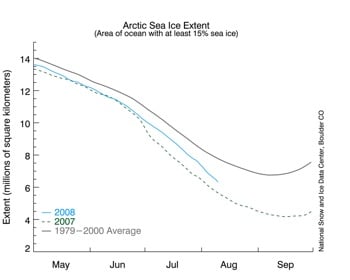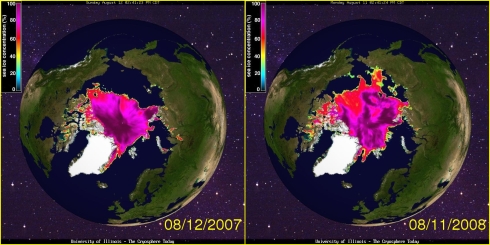19-square-mile ice sheet breaks loose in Canada
By CHARMAINE NORONHA – 1 day ago
TORONTO (AP) — A chunk of ice shelf nearly the size of Manhattan has broken away from Ellesmere Island in Canada's northern Arctic, another dramatic indication of how warmer temperatures are changing the polar frontier, scientists said Wednesday.
Derek Mueller, an Arctic ice shelf specialist at Trent University in Ontario, told The Associated Press that the 4,500-year-old Markham Ice Shelf separated in early August and the 19-square-mile shelf is now adrift in the Arctic Ocean.
"The Markham Ice Shelf was a big surprise because it suddenly disappeared. We went under cloud for a bit during our research and when the weather cleared up, all of a sudden there was no more ice shelf. It was a shocking event that underscores the rapidity of changes taking place in the Arctic," said Muller. Muller also said that two large sections of ice detached from the Serson Ice Shelf, shrinking that ice feature by 47 square miles — or 60 percent — and that the Ward Hunt Ice Shelf has also continued to break up, losing an additional eight square miles.
Muller reported last month that seven square miles of the 170-square-mile and 130-feet-thick Ward Hunt shelf had broken off. This comes on the heels of unusual cracks in a northern Greenland glacier, rapid melting of a southern Greenland glacier, and a near record loss for Arctic sea ice this summer. And earlier this year a 160-square mile chunk of an Antarctic ice shelf disintegrated.
"Reduced sea ice conditions and unusually high air temperatures have facilitated the ice shelf losses this summer," said Luke Copland, director of the Laboratory for Cryospheric Research at the University of Ottawa. "And extensive new cracks across remaining parts of the largest remaining ice shelf, the Ward Hunt, mean that it will continue to disintegrate in the coming years."
Formed by accumulating snow and freezing meltwater, ice shelves are large platforms of thick, ancient sea ice that float on the ocean's surface but are connected to land. Ellesmere Island was once entirely ringed by a single enormous ice shelf that broke up in the early 1900s. All that is left today are the four much smaller shelves that together cover little more than 299 square miles.
Martin Jeffries of the U.S. National Science Foundation and University of Alaska Fairbanks said in a statement Tuesday that the summer's ice shelf loss is equivalent to over three times the area of Manhattan, totaling 82 square miles — losses that have reduced Arctic Ocean ice cover to its second-biggest retreat since satellite measurements began 30 years ago.
"These changes are irreversible under the present climate and indicate that the environmental conditions that have kept these ice shelves in balance for thousands of years are no longer present," said Muller.
During the last century, when ice shelves would break off, thick sea ice would eventually reform in their place. "But "But today, warmer temperatures and a changing climate means there's no hope for regrowth. A scary scenario," said Muller. The loss of these ice shelves means that rare ecosystems that depend on them are on the brink of extinction, said Warwick Vincent, director of Laval University's Centre for Northern Studies and a researcher in the program ArcticNet.
"The Markham Ice Shelf had half the biomass for the entire Canadian Arctic Ice Shelf ecosystem as a habitat for cold, tolerant microbial life; algae that sit on top of the ice shelf and photosynthesis like plants would. Now that it's disappeared, we're looking at ecosystems on the verge of distinction,' said Muller.
Along with decimating ecosystems, drifting ice shelves and warmer temperatures that will cause further melting ice pose a hazard to populated shipping routes in the Arctic region — a phenomenon that Canada's Prime Minister Stephen Harper seems to welcome.
Harper announced last week that he plans to expand exploration of the region's known oil and mineral deposits, a possibility that has become more evident as a result of melting sea ice. It is the burning of oil and other fossil fuels that scientists say is the chief cause of manmade warming and melting ice.
Harper also said Canada would toughen reporting requirements for ships entering its waters in the Far North, where some of those territorial claims are disputed by the United States and other countries.
link



